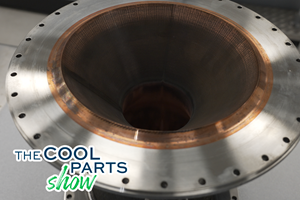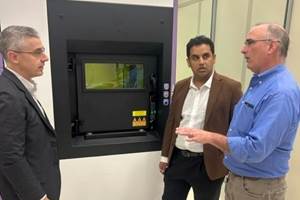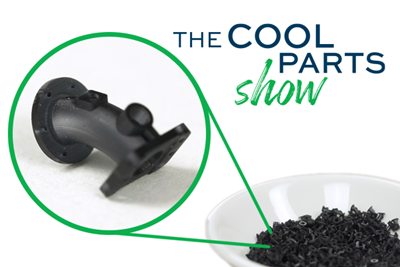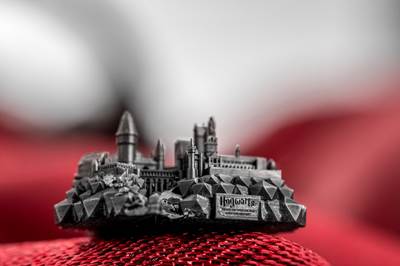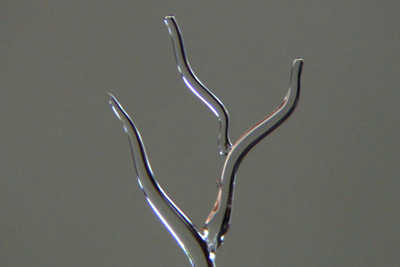Micro Robot Gripper 3D Printed All at Once, No Assembly Required: The Cool Parts Show #59
Fine control over laser powder bed fusion achieves precise spacing between adjoining moving surfaces. The Cool Parts Show looks at micro 3D printing of metal for moving components made in one piece.
Share
Scroll to unlock this premium content if video does not play.
Though assembly consolidation in additive manufacturing often refers to solid parts, AM that is sufficiently precise opens the door to 3D printing of moving assemblies made all in one build, without manual assembly work required. 3D MicroPrint uses a combination of low laser power and small metal powder size to achieve a small, controlled melt pool enabling fine precision in laser powder bed fusion.
One application the company has found is 3D printing actuated moving components that would be impractical to make through assembly, such as moving surgical robot grippers so small they can only be seen clearly under a magnifying glass. | This episode of The Cool Parts Show brought to you by Carpenter Additive
The Cool Parts Show is a video series from Additive Manufacturing Media that explores the what, how and why of unusual 3D printed parts. Watch more here.
Have a cool part to share? Email us.
Related Resources
- 3D MicroPrint
- AM Radio episode: Zooming in on Micro 3D Printing
- The Cool Parts Show on micro 3D printing for electronics connectors
- Subscribe to The BuildUp, a twice weekly newsletter from Additive Manufacturing Media
Transcript
00:00:00:11 - 00:00:00:22
Pete Zelinski
I'm Pete.
00:00:01:08 - 00:00:11:05
Stephanie Hendrixson
I'm Stephanie. And this is The Cool Parts Show, our show all about cool, interesting, innovative 3D printed parts. Today on the show, we have a tiny part that is so small you may not even be able to see it yet.
00:00:11:19 - 00:00:19:19
Pete Zelinski
It is here on the table, come in closer. It is this tiny little gripper for a medical robot made through laser powder bed fusion.
00:00:20:06 - 00:00:23:20
Stephanie Hendrixson
Micro 3D printing in metals. On this episode of the Cool Part show.
00:00:30:02 - 00:00:41:15
Pete Zelinski
The Cool Parts Show is brought to you by Carpenter Additive. When it comes to managing metal powder, there is no one size fits all approach. Stick around after the episode to learn more. Welcome to The Cool Parts Show.
00:00:42:01 - 00:00:51:21
Stephanie Hendrixson
If you like the show, help us out. Hit that subscribe button. Today we're going to be talking all about these tiny grippers used in surgical robots produced through a special version of laser powder bed fusion.
00:00:52:22 - 00:01:21:10
Pete Zelinski
So these 3D printed grippers have been made for various medical device makers. Different sizes, could be used on the end of the arm of a medical robot, could be used on a handheld device to get a biopsy sample. Some of these are so small that assembling the pieces of these moving gripper components would be very difficult. So they're not really made through assembly. These little grippers are 3D printed all in one piece.
00:01:25:04 - 00:01:42:00
Stephanie Hendrixson
So this is 3D printing taking the place of assembly. It's also an alternative to the way that these grippers might have been made out of sheet metal parts or metal injection molded parts. The 3D printing allows you to produce a mechanical device like this all in one go.
00:01:42:21 - 00:02:00:00
Pete Zelinski
What makes this possible, particularly these really small ones, is laser powder bed fusion with very, very fine powder. That's the specialty of a company we're going to introduce you to, 3D MicroPrint in Germany. Here is the general manager, Knut Hentschel.
00:02:01:06 - 00:02:38:18
Knut Hentschel
3D MicroPrint started in 3D printing or micro printing between EOS in the very beginning and 3D Micromac, which is a machine supplier for laser ablation machines back in 2006. And so within the year 2007 until 2008, we developed the technology for micro printing very fine small features with fine powders, built the first lab machine. And within 2013, finally, the company was founded. We use an ultra fine metal powder and a powderbed size in a single digit layer stack of microns. So therefore we have Low power laser with a very fine laser spot of less than 20 micron. Therefore we can build parts with very tiny features. The unique feature of the process is that we use poweder particles less than five micron.
And so with this we can leave small gaps in between parts getting their mechanical mechanisms already printed in and given the fine powder and the fine laser, we end up with a surface roughness of an Ra less than two microns and with a standard surface treatment we go down to an Ra less than one micron. Which is useful for very fine features.
00:03:39:01 - 00:04:11:07
Stephanie Hendrixson
So 3D micro print has developed this technology. They sell the machines, they also make parts themselves using this, and it works a lot like laser powder bed fusion that you've seen on other episodes of the show. Very, very similar. The difference here is that they're printing with really fine powder. They're spreading it in very thin layers and they're using a really tiny laser spot size to get parts that are really small with really fine features. That also allows the control to do things like mechanical grippers and other parts that don't need to be assembled, that can be usable almost right out of the printer.
00:04:11:22 - 00:04:52:17
Pete Zelinski
Yeah, lots of different ways to 3D print in metal. Laser powder bed fusion is a method we talk about a lot on this show and it's basically building a part by melting grain after grain of metal powder. And the resolution you achieve is based on that powder melting. And so if you can use very small grains of powder and low laser power to get small melt pools, combined with very tiny layers in your 3D printing, all of that allows you to achieve a resolution, a precision that we don't usually associate with laser powder bed fusion.
00:04:53:16 - 00:05:30:23
Knut Hentschel
The feature sizes we can do starts within the first line we do on a single powderbed. So a powderbed size usually is somewhere about five microns, but we also can go down to one micron if we get the powder for it, which is in set dimension and in X-Y dimension. We are on a single build plate or for single pieces, starting with a five micron. In the first centimeter in the square, and then going out to the edges of the building platform, we can guarantee a detail size of less than 25 micron.
00:05:37:19 - 00:06:05:15
Stephanie Hendrixson
There's another advantage of this process that comes from the powder itself. Knut says that they are typically printing with powders that have a grain size of around five microns, which is pretty small. So your typical laser powder bed fusion material would be something like 20 microns or even much bigger than that, there's a real range. But because the superfine powder doesn't flow in the same way that you might be used to, it allows them to do things like printing overhangs and gaps between parts without using support structures as much as we're used to seeing with laser powder bed fusion.
00:06:09:00 - 00:06:39:19
Pete Zelinski
So that gets us to these grippers. So could be used in a medical robot, could be used on a fine medical device, handheld device. Grippers like these have been made for various customers, various medical device makers. This one is made of stainless steel. It's possible in part because of something you said, no need for support structures. So it wouldn't be practical to make something like this or something like the even smaller one if there was a need to go in there and remove cut away support structures that had been necessary to produce this. But it also illustrates what's possible not just in in producing very, very fine features, but producing very, very fine not features, because to produce a moving component all in one piece requires control over the tiny gap between moving surfaces.
That empty space, that controlled empty space in the moving component is what makes it possible to produce this object that is an assembly that's not really assembled.
00:07:26:12 - 00:07:55:16
Knut Hentschel
We do the grippers in several kinds of geometries for direct customers. They are used for surgical a robot or for handheld devices. So we can add also any kind of surfaces to the gripping surface of the device itself, and we can do several varying sizes of them. Actually, we have the gripper in a dimension, the smallest one, at 800 micron diameter.
So it fits to a 0.9 hollow needle taking biopsies. And the recent request is to get them down to a diameter of 600 microns. So just to cut off a fifth of them. So the gripper component is one of the printers one assembly we do which starts in the minimum at at least five parts, sometimes there are 7 to 8 parts, which we print in a single process. So just leaving small gaps where you have joints or hinges and something like this. So the tiny gaps are somewhere between ten and 15, 20 microns depending on the size of the gripper or the size of the powder we are using on them.
00:08:50:18 - 00:09:07:07
Stephanie Hendrixson
So going to 3D printing for something like these grippers means that you no longer have to make seven or eight individual parts and put them all together. You get to skip that assembly step, but you also get to skip a lot of the qualification work for something like a medical device. Instead of producing all of those parts and qualifying them individually and then the device as a whole, you can just do that one time with this 3D printing gripper.
00:09:12:13 - 00:09:41:04
Pete Zelinski
Some of these grippers are so small they could only be made additively, but some of them are just kind of small. And a gripper this size could be made with small sheet metal pieces assembled together. But the advantages of reducing the assembly and qualification by printing it all in one piece in some cases can make the micro 3D printing competitive even for a gripper like this one that is relatively large.
00:09:46:08 - 00:10:12:23
Knut Hentschel
It's just the printing time and cleaning of the parts, a little bit of EDM wiring, and the part is finished, which reduces the production time a lot. And we have also the possibility that you only have to do one certification, one quality inspection of the part. That's the trade off. Certainly it's a little bit more expensive than the seperate pieces to be assembled, But finally you have a single piece which is sturdier than assembled parts since you don't have splints or hinges or something like this and it's easier and shorter to produce.
00:10:28:21 - 00:10:48:06
Stephanie Hendrixson
So this technology is a great fit for these medical grippers. But we should note that 3D MicroPrint serves lots of different markets. They make lots of different things, parts for aerospace, for the jewelry and watch industry, other types of medical devices. And the parts that we have here are stainless steel, but they can print with inconel, bronze, brass, precious metals. There are a whole lot of possibilities for this.
00:10:50:17 - 00:10:52:19
Pete Zelinski
A lot to say about these little grippers. Let's wrap this up.
00:10:53:03 - 00:11:11:13
Stephanie Hendrixson
All right. These are 3D printed grippers for a surgical robot or other type of medical device. They were made by 3D MicroPrint using a form of laser powder bed fusion that uses very fine powders, very thin layers, and very small laser spot sizes to control the melt pool, to be able to produce tiny, tiny parts with tiny, tiny features.
00:11:12:04 - 00:11:40:14
Pete Zelinski
It's not just an example of 3D printing tiny objects. It's also a case of assembly consolidation. These moving grippers would normally have to be assembled together from various pieces, but fine control, not just over where the metal is placed, but where it's not placed allows for the creation of freely moving assemblies that don't have to be assembled because they're printed all in one piece.
00:11:41:09 - 00:11:49:08
Stephanie Hendrixson
That's it for this episode of The Cool Parts Show. If you like the show, subscribe, hit that bell icon so you get notified about new episodes and consider sharing it with a friend.
00:11:49:16 - 00:11:58:22
Pete Zelinski
If you have a cool part you'd like to share with us. We are very gentle with delicate, cool parts. Email us CoolParts@AdditiveManufacturing.media.
00:11:59:03 - 00:11:59:22
Stephanie Hendrixson
Thanks for watching.
00:12:00:11 - 00:12:23:17
Pete Zelinski
This episode is brought to you by Carpenter Additive. We're past the point of not knowing how to qualify metal 3D printed parts. We know it's just that different end users of those parts have different qualification requirements. Additive manufacturing service providers have to navigate that and Carpenter Additive has to think about that in tailoring powder management solutions.
00:12:24:08 - 00:12:52:22
William Herbert
Our customers typically, if they are a service provider, they will have a series of end user customers who may be say OEMs in the aerospace world, and each of them has a fairly large team of engineers who have been doing this for decades or more and have developed all these standards, regulations, paperwork. So it is certainly a challenge to thread the needle between all of these different requirements. We start really high level. We walk on the shop floor, we ask them about their source to sink, how do you bring in the materials, goods in, send that material to each of the systems. And then what we're really interested in is how do they reuse that material? So what we do is called a value stream map. Pretty often that leads to a series of things that were either overlooked or hadn't really boiled up to the surface yet in terms of things that are potential risks or potential challenges or inefficiencies that exist. A lot of the customers we work with, especially in the more regulated industries such as space or medical aerospace, have already been through those early learning stages. They've put five plus years into this. They've done the product design and the design for additive manufacturing, and now they're starting to reach some of the more finicky problems that you get when you're at the scale of maybe five, ten machines. You're running different materials simultaneously, you're doing different programs. We get to take the best from the medical field and the aerospace field. We understand the specifications and the standards that exist in each of those fields, and we can sort of take the best elements of those and customize that to what customers.
Related Content
Additive Manufacturing Is Subtractive, Too: How CNC Machining Integrates With AM (Includes Video)
For Keselowski Advanced Manufacturing, succeeding with laser powder bed fusion as a production process means developing a machine shop that is responsive to, and moves at the pacing of, metal 3D printing.
Read MoreDMG MORI: Build Plate “Pucks” Cut Postprocessing Time by 80%
For spinal implants and other small 3D printed parts made through laser powder bed fusion, separate clampable units resting within the build plate provide for easy transfer to a CNC lathe.
Read More3D Printed NASA Thrust Chamber Assembly Combines Two Metal Processes: The Cool Parts Show #71
Laser powder bed fusion and directed energy deposition combine for an integrated multimetal rocket propulsion system that will save cost and time for NASA. The Cool Parts Show visits NASA’s Marshall Space Flight Center.
Read MoreNew Zeda Additive Manufacturing Factory in Ohio Will Serve Medical, Military and Aerospace Production
Site providing laser powder bed fusion as well as machining and other postprocessing will open in late 2023, and will employ over 100. Chief technology officer Greg Morris sees economic and personnel advantages of serving different markets from a single AM facility.
Read MoreRead Next
Micro 3D Printing for Tiny Connectors: The Cool Parts Show #20
Microscale additive manufacturing offers an alternative to micromolding and micromachining. On this episode of The Cool Parts Show, 3D printed electrical connectors are our smallest cool part yet.
Read MoreZooming in on Micro 3D Printing: AM Radio #10A
This week on AM Radio, Peter Zelinski and Julia Hider discuss additive at the extremes, including micro 3D printing. What are the opportunities and challenges of 3D printing on a microscale?
Read MoreIce 3D Printing of Sacrificial Structures as Small as Blood Vessels
Using water for sacrificial tooling, Carnegie Mellon researchers have created a microscale method for 3D printing intricate structures small enough to create vasculature in artificial tissue. The biomedical research potentially has implications for other microscale and microfluidics applications.
Read More










